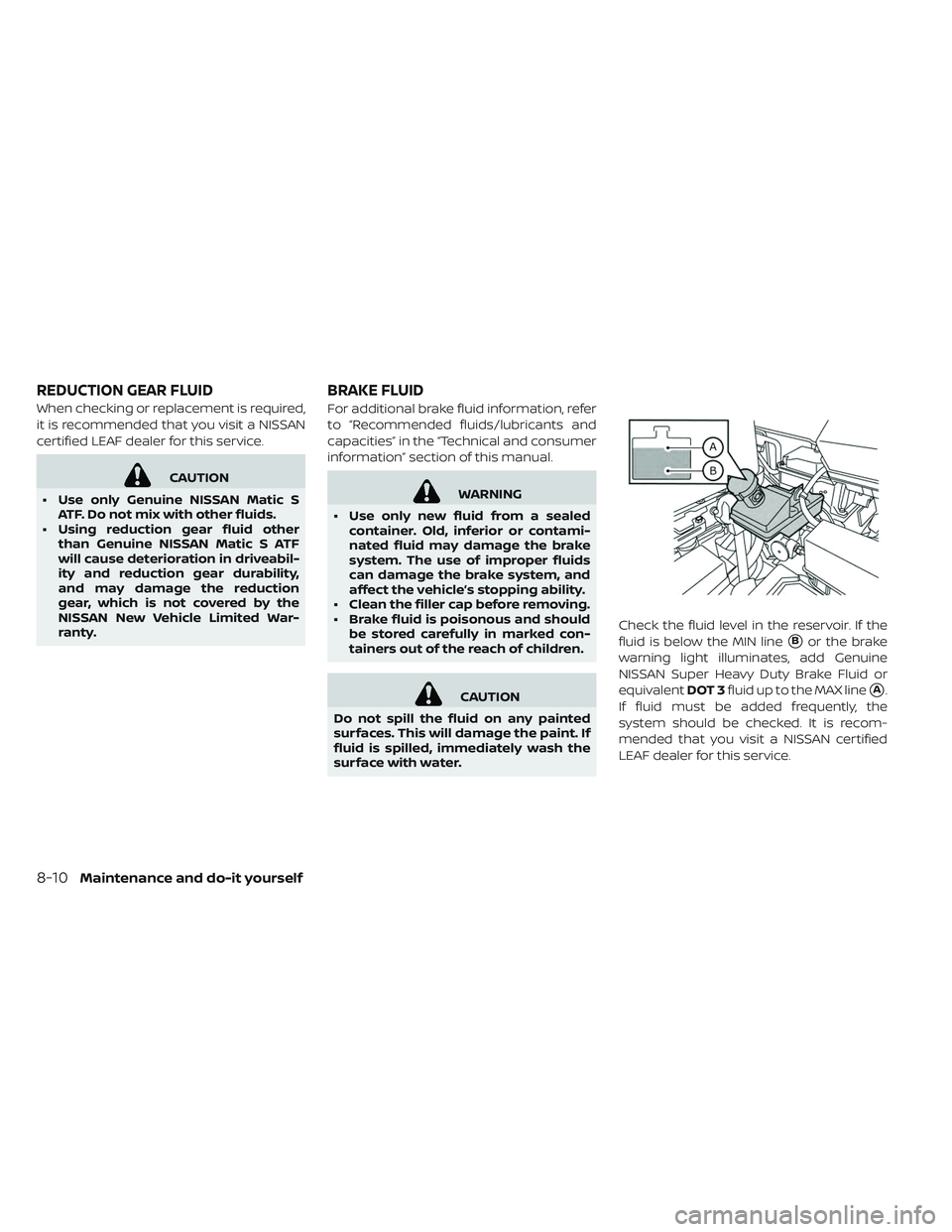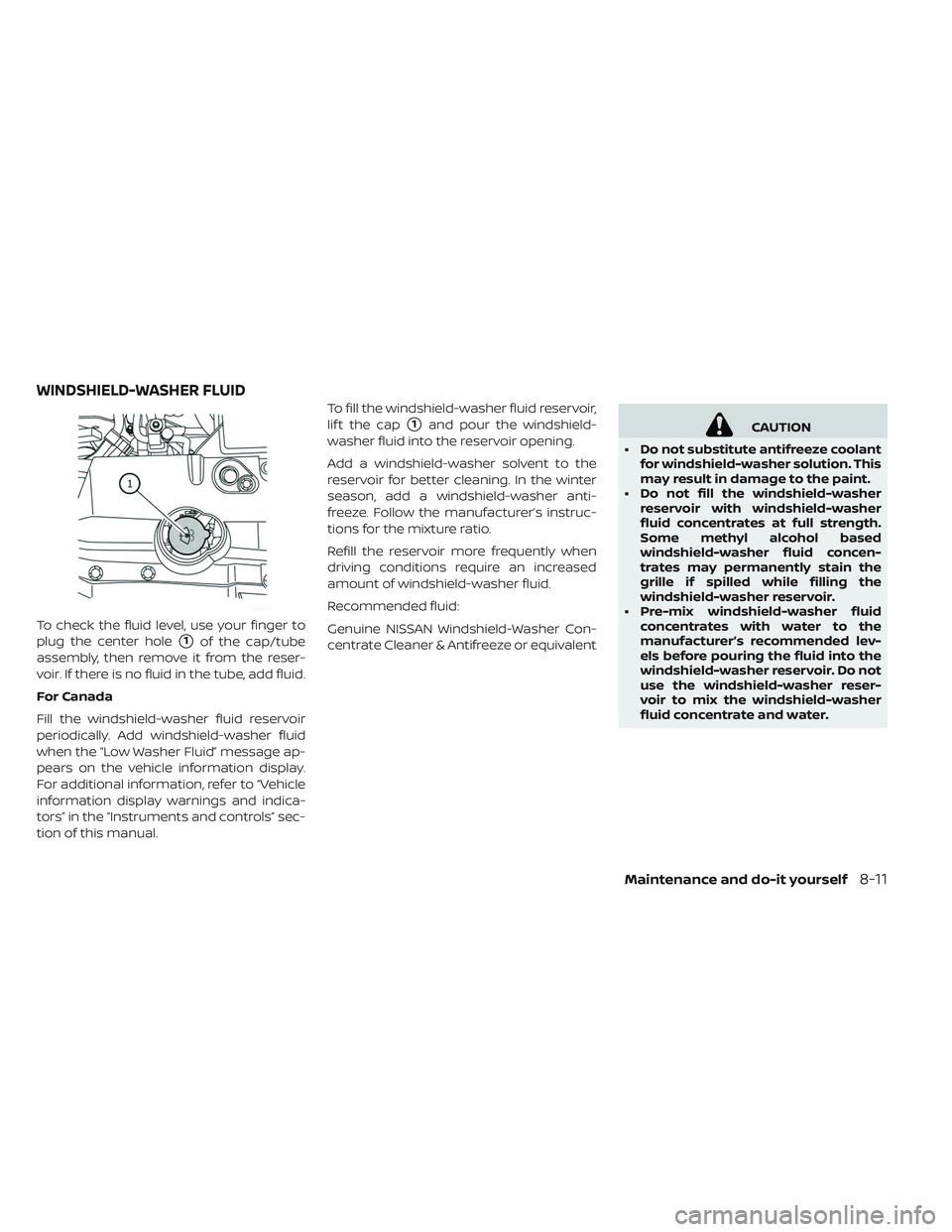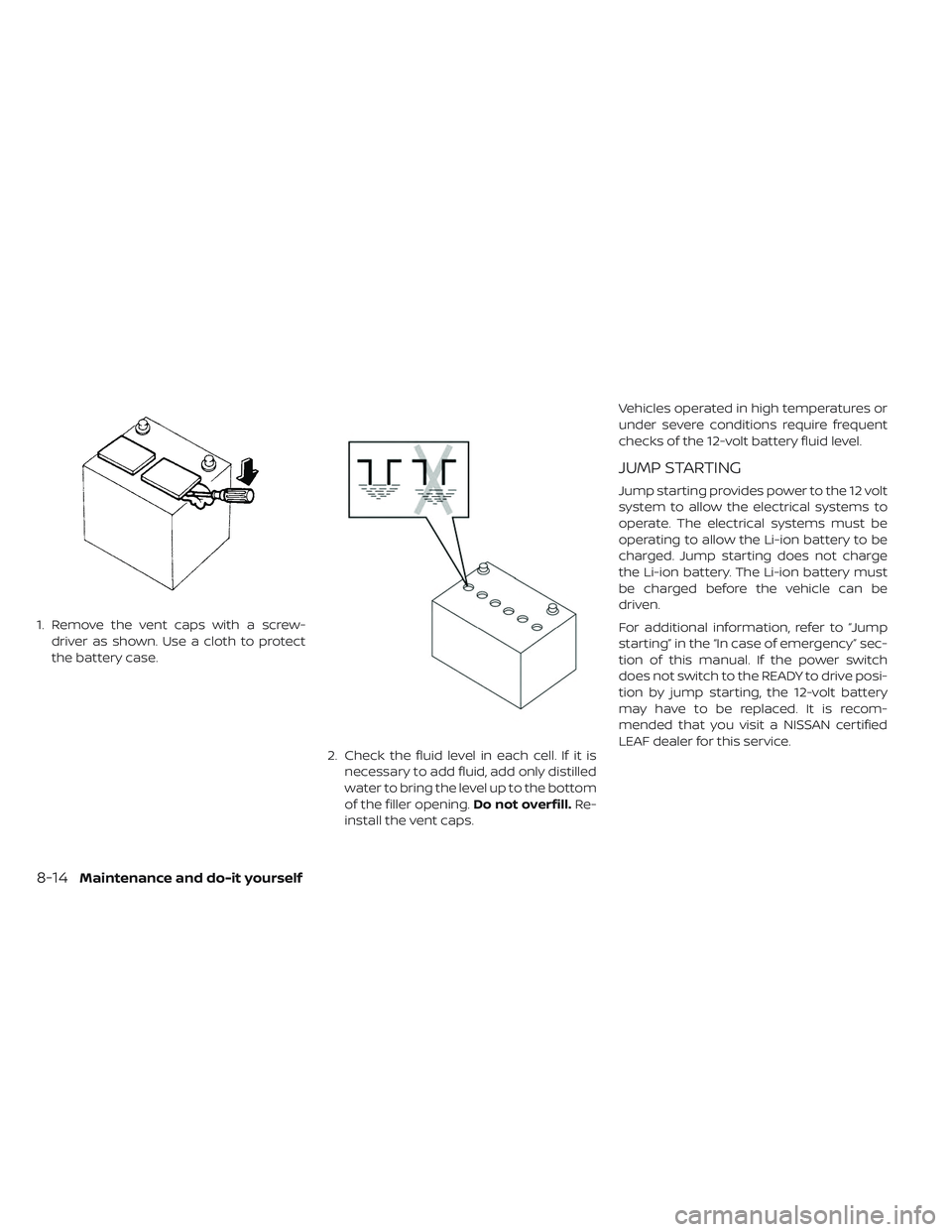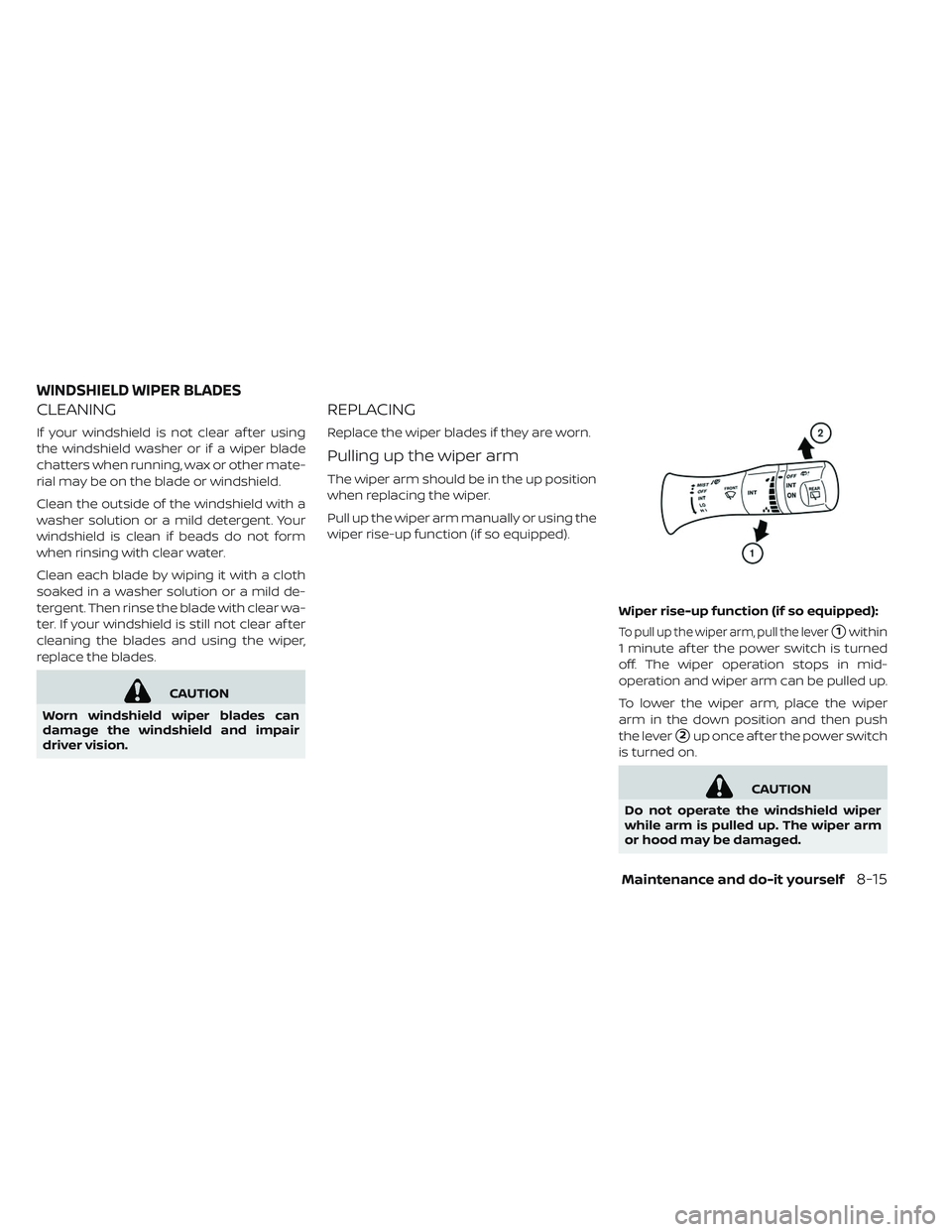Page 549 of 610

When checking or replacement is required,
it is recommended that you visit a NISSAN
certified LEAF dealer for this service.
CAUTION
• Use only Genuine NISSAN Matic S ATF. Do not mix with other fluids.
• Using reduction gear fluid other than Genuine NISSAN Matic S ATF
will cause deterioration in driveabil-
ity and reduction gear durability,
and may damage the reduction
gear, which is not covered by the
NISSAN New Vehicle Limited War-
ranty. For additional brake fluid information, refer
to “Recommended fluids/lubricants and
capacities” in the “Technical and consumer
information” section of this manual.
WARNING
• Use only new fluid from a sealed container. Old, inferior or contami-
nated fluid may damage the brake
system. The use of improper fluids
can damage the brake system, and
affect the vehicle’s stopping ability.
• Clean the filler cap before removing.
• Brake fluid is poisonous and should be stored carefully in marked con-
tainers out of the reach of children.
CAUTION
Do not spill the fluid on any painted
surfaces. This will damage the paint. If
fluid is spilled, immediately wash the
surface with water. Check the fluid level in the reservoir. If the
fluid is below the MIN line
�Bor the brake
warning light illuminates, add Genuine
NISSAN Super Heavy Duty Brake Fluid or
equivalent DOT 3fluid up to the MAX line
�A.
If fluid must be added frequently, the
system should be checked. It is recom-
mended that you visit a NISSAN certified
LEAF dealer for this service.
REDUCTION GEAR FLUID BRAKE FLUID
8-10Maintenance and do-it yourself
Page 550 of 610

To check the fluid level, use your finger to
plug the center hole
�1of the cap/tube
assembly, then remove it from the reser-
voir. If there is no fluid in the tube, add fluid.
For Canada
Fill the windshield-washer fluid reservoir
periodically. Add windshield-washer fluid
when the “Low Washer Fluid” message ap-
pears on the vehicle information display.
For additional information, refer to “Vehicle
information display warnings and indica-
tors” in the “Instruments and controls” sec-
tion of this manual. To fill the windshield-washer fluid reservoir,
lif t the cap
�1and pour the windshield-
washer fluid into the reservoir opening.
Add a windshield-washer solvent to the
reservoir for better cleaning. In the winter
season, add a windshield-washer anti-
freeze. Follow the manufacturer’s instruc-
tions for the mixture ratio.
Refill the reservoir more frequently when
driving conditions require an increased
amount of windshield-washer fluid.
Recommended fluid:
Genuine NISSAN Windshield-Washer Con-
centrate Cleaner & Antifreeze or equivalentCAUTION
• Do not substitute antifreeze coolant for windshield-washer solution. This
may result in damage to the paint.
• Do not fill the windshield-washer reservoir with windshield-washer
fluid concentrates at full strength.
Some methyl alcohol based
windshield-washer fluid concen-
trates may permanently stain the
grille if spilled while filling the
windshield-washer reservoir.
• Pre-mix windshield-washer fluid concentrates with water to the
manufacturer’s recommended lev-
els before pouring the fluid into the
windshield-washer reservoir. Do not
use the windshield-washer reser-
voir to mix the windshield-washer
fluid concentrate and water.
WINDSHIELD-WASHER FLUID
Maintenance and do-it yourself8-11
Page 551 of 610
• Keep the 12-volt battery surface clean anddry. Clean the 12-volt battery with a solu-
tion of baking soda and water.
• Make certain the terminal connections are clean and securely tightened.
12-VOLT BATTERY
8-12Maintenance and do-it yourself
Page 552 of 610

NOTE:
Care should be taken to avoid situations
that can lead to potential battery dis-
charge and potential no-start conditions
such as:
1.Installation or extended use of elec-
tronic accessories that consume bat-
tery power when the EV system is not
running (Phone chargers, GPS, DVD
players, etc.)
2. Vehicle is not driven regularly and/or
only driven short distances.
In these cases, the battery may need to
be charged to maintain battery healthWARNING
• Do not expose the 12-volt battery to flames or electrical sparks. Hydro-
gen gas generated by the 12-volt
battery is explosive. Do not allow 12-
volt battery fluid to contact your
skin, eyes, fabrics or painted sur-
faces. Af ter touching a 12-volt bat-
tery or 12-volt battery cap, do not
touch or rub your eyes. Thoroughly
wash your hands. If the acid con-
tacts your eyes, skin or clothing, im-
mediately flush with water for at
least 15 minutes and seek medical
attention.
• Do not operate the vehicle if the fluid in the 12-volt battery is low. Low 12-
volt battery fluid can cause a higher
load on the 12-volt battery which
can generate heat, reduce battery
life, and in some cases lead to an
explosion. • When working on or near a 12-volt
battery, always wear suitable eye
protection and remove all jewelry.
• 12-volt battery posts, terminals and related accessories contain lead and
lead compounds. Wash hands af ter
handling.
• Keep the 12-volt battery out of the reach of children.
Maintenance and do-it yourself8-13
Page 553 of 610

1. Remove the vent caps with a screw-driver as shown. Use a cloth to protect
the battery case.
2. Check the fluid level in each cell. If it isnecessary to add fluid, add only distilled
water to bring the level up to the bottom
of the filler opening. Do not overfill.Re-
install the vent caps. Vehicles operated in high temperatures or
under severe conditions require frequent
checks of the 12-volt battery fluid level.
JUMP STARTING
Jump starting provides power to the 12 volt
system to allow the electrical systems to
operate. The electrical systems must be
operating to allow the Li-ion battery to be
charged. Jump starting does not charge
the Li-ion battery. The Li-ion battery must
be charged before the vehicle can be
driven.
For additional information, refer to “Jump
starting” in the “In case of emergency” sec-
tion of this manual. If the power switch
does not switch to the READY to drive posi-
tion by jump starting, the 12-volt battery
may have to be replaced. It is recom-
mended that you visit a NISSAN certified
LEAF dealer for this service.
8-14Maintenance and do-it yourself
Page 554 of 610

CLEANING
If your windshield is not clear af ter using
the windshield washer or if a wiper blade
chatters when running, wax or other mate-
rial may be on the blade or windshield.
Clean the outside of the windshield with a
washer solution or a mild detergent. Your
windshield is clean if beads do not form
when rinsing with clear water.
Clean each blade by wiping it with a cloth
soaked in a washer solution or a mild de-
tergent. Then rinse the blade with clear wa-
ter. If your windshield is still not clear af ter
cleaning the blades and using the wiper,
replace the blades.
CAUTION
Worn windshield wiper blades can
damage the windshield and impair
driver vision.
REPLACING
Replace the wiper blades if they are worn.
Pulling up the wiper arm
The wiper arm should be in the up position
when replacing the wiper.
Pull up the wiper arm manually or using the
wiper rise-up function (if so equipped).
Wiper rise-up function (if so equipped):
To pull up the wiper arm, pull the lever�1within
1 minute af ter the power switch is turned
off. The wiper operation stops in mid-
operation and wiper arm can be pulled up.
To lower the wiper arm, place the wiper
arm in the down position and then push
the lever
�2up once af ter the power switch
is turned on.
CAUTION
Do not operate the windshield wiper
while arm is pulled up. The wiper arm
or hood may be damaged.
WINDSHIELD WIPER BLADES
Maintenance and do-it yourself8-15
Page 555 of 610
Replacing
1. Push the release tab�A, and move the
wiper blade down the wiper arm
�B
while pushing the release tab to remove.
2. Insert the new wiper blade onto the wiper arm until a click sounds.
3. Rotate the wiper blade so that the dimple is in the groove.
CAUTION
• Af ter wiper blade replacement, re- turn the wiper arm to its original po-
sition; otherwise it may be damaged
when the hood is opened.
• Make sure the wiper blades contact the glass; otherwise the arm may be
damaged from wind pressure. Be careful not to clog the washer nozzle
�A.
This may cause improper windshield
washer operation. If the nozzle is clogged,
remove any objects with a needle or small
pin
�B. Be careful not to damage the nozzle.
8-16Maintenance and do-it yourself
Page 556 of 610

REAR WINDOW WIPER BLADE
It is recommended that you visit a NISSAN
certified LEAF dealer if checking or replace-
ment is required.If the brakes do not operate properly, have
the brakes checked. It is recommended
that you visit a NISSAN certified LEAF dealer
for this service.
WARNING
Do not adjust the height of the brake
pedal. Doing so could alter the effec-
tiveness of the brakes, which could re-
sult in a serious accident and personal
injury. If adjustment is required, it is
recommended that you visit a NISSAN
certified LEAF dealer for this service.
BRAKE PAD WEAR WARNING
The disc brake pads have audible wear
warnings. When a brake pad requires re-
placement, it will make a high pitched
scraping sound when the vehicle is in mo-
tion. This scraping sound will first occur
only when the brake pedal is depressed.
Af ter more wear of the brake pad, the
sound will always be heard even if the
brake pedal is not depressed. Have the
brakes checked as soon as possible if the
wear warning sound is heard. Under some driving or climate conditions,
occasional brake squeak, squeal or other
noise may be heard. Occasional brake
noise during light to moderate stops is nor-
mal and does not affect the function or
performance of the brake system.
Proper brake inspection intervals should
be followed.
For additional information, re-
fer to the maintenance log section of your
NISSAN Service and Maintenance Guide.
BRAKES
Maintenance and do-it yourself8-17